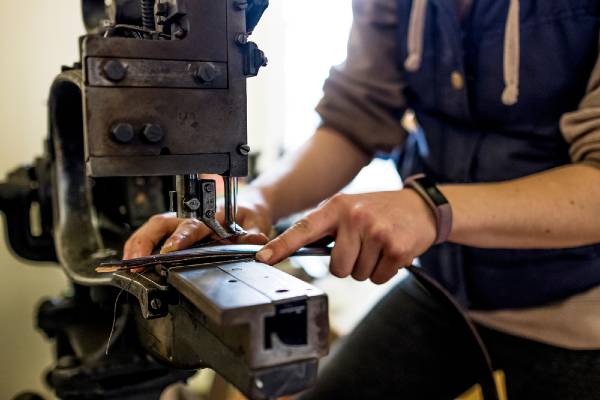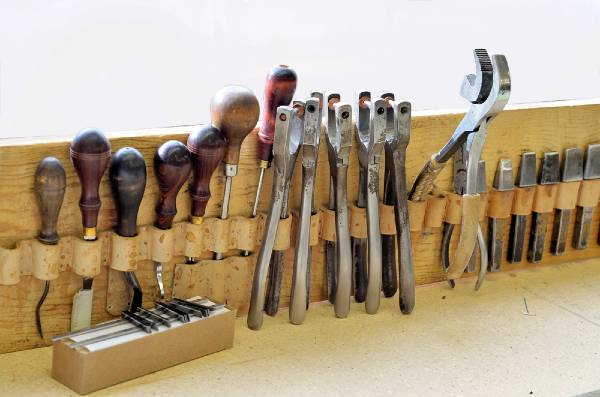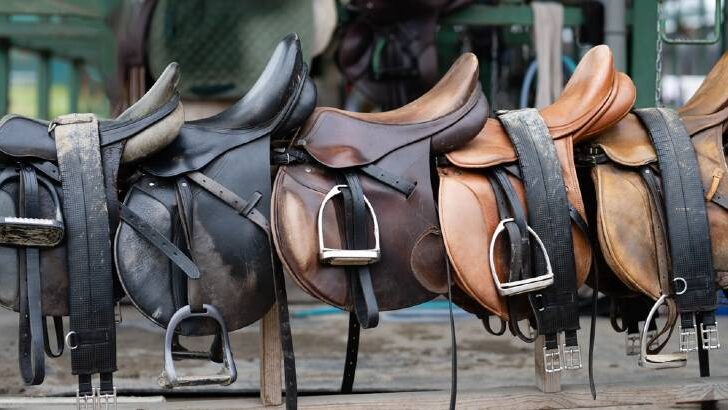Affiliate Disclaimer
As an Amazon Associate I earn from qualifying purchases. It helps me keep the website going. Thank you for your support.
Saddles are a vital part of every equestrian’s tack room. Without them, we would all be riding bareback! Making saddles, and other leather pieces of tack like bridles or halters, is a highly skilled craft. Becoming a saddle maker often involves many years of experience, and many hours of work put into making each piece. But where did they learn all their skills from?
There is no single pathway to becoming a saddle maker. Often, learning the knowledge and skills required is done via a number of avenues. These can include completing leatherworking and saddle making courses. Learning from a mentor is a valuable way to learn the little-known tricks of the trade. As you develop your skills, you will likely invent new ways to make or design saddles and tack.
Saddle making is a form of highly skilled art and craftsmanship. It takes a long time to develop the skills to be able to design and make a saddle. Read on to learn more about how to develop saddle making into a rewarding career.

What Is A Saddle Maker?
Put simply, a saddle maker is someone who makes saddles. More often than not, these people also make and repair other leather saddlery items, like bridles. Saddle makers are highly skilled craftspeople who have a genuine love for horses and leatherwork.
Because they are skilled with leather, saddle makers often turn their hands to making other items. Common things saddle makers also produce include bridles, girths, reins, stirrup leathers, and halters. Their skills are not limited to horses – some also produce belts, dog collars, or leather bags.
Making a saddle from scratch is an intricate process. There are many different components that make up a saddle. These must be designed and connected in such a way that is comfortable for horse and rider.
Key Steps To Becoming A Saddle Maker
There are many different pathways to becoming a saddle maker. Most saddle makers will have taken their own individual pathway to learn the craft. They will likely have also combined some of the methods. This means that while they may have done a saddle making course, they might have also worked alongside a mentor.
Here is a summary of the steps you could take to become a saddle maker:
1. Learn Basic Leatherworking Skills
Before working on saddles, make sure you have good skills in basic leatherwork. This includes cutting, dying, stitching, tooling, and finishing leather. These skills will be essential to your success as a saddle maker.
To learn these skills, you could enroll in a local leatherworking class. If there isn’t one close by, you can attend workshops or complete an online course. These courses are often relatively short and are designed to give you the basic skills required.
Alternatively, you could learn these skills from a mentor. This person could be a saddle maker themselves, or someone who makes other items from leather.

2. Study Saddle Design and Equine Anatomy
This step is important if you want to be able to design your own saddles. You need to be able to understand what components make up a saddle and how they all work together. This will help you to create a saddle that is functional.
You also need to understand how a saddle fits onto a horse. This will prevent you from designing a saddle that is beautiful to look at but can never be used. This may be because you have made a particular area too wide or narrow, or with too much or too little padding.
One of the best ways to learn these skills is by working with a saddle fitter. These people have likely completed a qualification that enables them to fit saddles to horses. Fitting saddles can also be an art, as every horse and rider combination is different.
Alternatively, you could learn these skills by completing a saddle fitting course or qualification. This will give you an advanced understanding of equine and rider anatomy. However, having this knowledge will stand you in very good stead as a saddle maker.
3. Learn Saddle Making Techniques
There is more to making saddles than simply leatherwork. There are specialized skills that you need to have to be able to make a saddle from scratch. These include knowing how to make the tree for the saddle, and how to flock the panels.
The tree is the frame upon which the saddle is built. It can be made from a variety of different materials, including wood or fiberglass. You may be able to purchase pre-made trees and remodel them to suit. Or, you may want to learn how to mold your own from scratch.
You will also need to learn how to flock the panels of the saddle. These are the parts of the saddle that sit along the horse’s back, on either side of the spine. You need to be able to fill the panels with flock evenly. If you don’t there will be pressure points along the horse’s back.
There are two main ways that you can learn these skills. You can work alongside a saddle maker as a mentor. They will show you their process and teach you what they have learned. Alternatively, you can complete a saddle making course.
Another great way to learn is to purchase saddles that are still serviceable but need repair. This gives you the opportunity to pull the saddle apart and see how it is made. You can then restore the leather and rebuild the saddle. Doing this many times can show you what works and doesn’t work in saddle design. Plus, you can use or sell the restored saddle at the end.
4. Gain Hands-on Experience
Now is the time to practice and refine your skills. Start by creating more simple designs, and as you improve your skills, move on to more advanced projects. Restoring old tack is a great way to learn, as well as making things from scratch.
Now is also a good time to visit horses and riders to cement your understanding of how saddles fit. It can be beneficial to be involved in the process to fit a saddle that you have made. This will help you identify any areas in which your work could be improved.
Having access to a mentor at this stage can accelerate your success. You will be able to get support if you run into any issues in the saddle making process. They will also be able to teach you more advanced skills as you progress.

5. Launch Your Saddle Making Business
If your ultimate goal is to run your own saddle making business, now is the time to make a start. You will need to develop a portfolio of your work to showcase. Traveling, and being involved in the saddle fitting process is a good way to build a network of clients.
Attending equestrian events, trade shows, and saddle making workshops is also a great way to build a network. Doing this can lead to partnership opportunities and new clients. It can also lead to further skill development by making contact with high-profile saddle makers.
What Tools Do I Need When Becoming a Saddle Maker?
There are a number of different tools that you will need to invest in to work as a saddle maker. Often, you can purchase hobby-grade hand tools to start off with. Then, as your knowledge grows, you can advance to higher quality and more advanced tools.
To start with, you need a space in which to house your tools and leatherwork. The size of your shop will depend on how big you want your business to grow. Sheds work well for saddle making shops, however, are best with insulation, climate control, and good lighting. This will help keep leather and tools in good condition – and keep you comfortable!
There are also some major investments you will need to make. One of these is two sewing machines – one for heavy work, and a second for lighter and finer work. The initial outlay for a quality machine can be significant, up to $5,000. However, a quality machine that is well cared for will last for many years.
Other items you might consider purchasing include a drill press, a bandsaw, or cutting torches. The list of tools and facilities depends on how many different services you want to offer. (source)

Do You Have to Be Qualified to Become a Saddle Maker?
In short, no – you do not have to complete a qualification to become a saddle maker. You can work as a saddle maker, or start your own business, without any formal qualifications. However, there are courses available to help you become a saddle maker.
Having a qualification can set a benchmark for your work. Also, customers will know that you have definitely completed training and can trust your skills. However, having experience is just as important as having a qualification.
Final Thoughts
While the path to becoming a saddle maker can require a lot of time and effort, it leads to a very rewarding career. You will have the pleasure of being able to design a beautiful yet functional saddle that suits your customer. All in all consider becoming a saddle maker if you have a passion for horses, leatherwork, attention to detail, and creativity.




